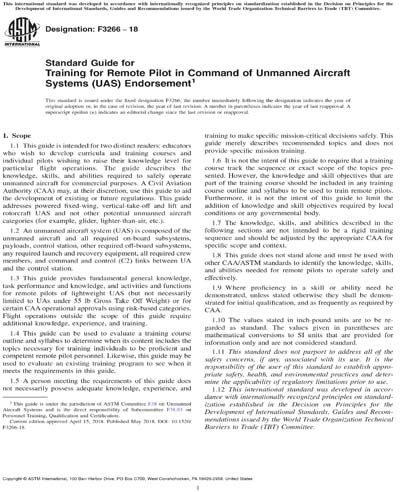Historical
ASTM F3266-18
Standard Guide for Training for Remote Pilot in Command of Unmanned Aircraft Systems (UAS) Endorsement
1.1 This guide is intended for two distinct readers: educators who wish to develop curricula and training courses and individual pilots wishing to raise their knowledge level for particular flight operations. The guide describes the knowledge, skills, and abilities required to safely operate unmanned aircraft for commercial purposes. A Civil Aviation Authority (CAA) may, at their discretion, use this guide to aid the development of existing or future regulations. This guide addresses powered fixed-wing, vertical-take-off and lift and rotorcraft UAS and not other potential unmanned aircraft categories (for example, glider, lighter-than-air, etc.).
1.2 An unmanned aircraft system (UAS) is composed of the unmanned aircraft and all required on-board subsystems, payloads, control station, other required off-board subsystems, any required launch and recovery equipment, all required crew members, and command and control (C2) links between UA and the control station.
1.3 This guide provides fundamental general knowledge, task performance and knowledge, and activities and functions for remote pilots of lightweight UAS (but not necessarily limited to UAs under 55 lb Gross Take Off Weight) or for certain CAA operational approvals using risk-based categories. Flight operations outside the scope of this guide require additional knowledge, experience, and training.
1.4 This guide can be used to evaluate a training course outline and syllabus to determine when its content includes the topics necessary for training individuals to be proficient and competent remote pilot personnel. Likewise, this guide may be used to evaluate an existing training program to see when it meets the requirements in this guide.
1.5 A person meeting the requirements of this guide does not necessarily possess adequate knowledge, experience, and training to make specific mission-critical decisions safely. This guide merely describes recommended topics and does not provide specific mission training.
1.6 It is not the intent of this guide to require that a training course track the sequence or exact scope of the topics presented. However, the knowledge and skill objectives that are part of the training course should be included in any training course outline and syllabus to be used to train remote pilots. Furthermore, it is not the intent of this guide to limit the addition of knowledge and skill objectives required by local conditions or any governmental body.
1.7 The knowledge, skills, and abilities described in the following sections are not intended to be a rigid training sequence and should be adjusted by the appropriate CAA for specific scope and context.
1.8 This guide does not stand alone and must be used with other CAA/ASTM standards to identify the knowledge, skills, and abilities needed for remote pilots to operate safely and effectively.
1.9 Where proficiency in a skill or ability need be demonstrated, unless stated otherwise they shall be demonstrated for initial qualification, and as frequently as required by CAA.
1.10 The values stated in inch-pound units are to be regarded as standard. The values given in parentheses are mathematical conversions to SI units that are provided for information only and are not considered standard.
1.11 This standard does not purport to address all of the safety concerns, if any, associated with its use. It is the responsibility of the user of this standard to establish appropriate safety, health, and environmental practices and determine the applicability of regulatory limitations prior to use.
1.12 This international standard was developed in accordance with internationally recognized principles on standardization established in the Decision on Principles for the Development of International Standards, Guides and Recommendations issued by the World Trade Organization Technical Barriers to Trade (TBT) Committee.
Content Provider
ASTM International [astm]






